WHITE PAPER
Femtosecond Amplifier Provides Turnkey Access to Extreme Operating Regimes
The superior beam quality and long-term stability of the Astrella regenerative amplifier makes it an ideal turnkey engine for experiments in extreme operating regimes that formerly required complex sources and considerable laser expertise. This whitepaper explains how this industrial-grade ultrafast amplifier can be used to reach pulse widths shorter than 5 fs, generate EUV wavelengths down to 13 nm, and perform broadband two-dimensional spectroscopy scans lasting 48 hours.
Titanium:Sapphire Regenerative Amplifiers
While newer laser gain materials like ytterbium-doped fiber are increasingly used for applications in femtosecond science, the uniquely wide bandwidth and gain characteristics of titanium:sapphire (Ti:Sapphire) mean this well-proven technology remains unchallenged for applications needing very high pulse energies and/or extremely short pulse widths at the most popular repetition rates of 1-5 kHz. The best laser architecture for fulfilling these performances is based on Chirped Pulse Amplification (CPA) with a regenerative amplifier. Here the output of a ~80 MHz Ti:Sapphire femtosecond oscillator is stretched (chirped) to tens of picoseconds, then dropped to the kilohertz domain by a fast optical gate before being amplified in a single or multistage amplifier pumped by a Q-switched green laser. The amplified pulse – a replica of the input pulse – is then compressed to the initial pulse duration. Vertically integrated laser manufacturers like Coherent offer all these components – oscillator, amplifier, pump lasers – as separate devices that can be combined to achieve the desired performances. In order to make amplified femtosecond pulses available to the broadest possible user-base, we also provide “one-box” amplifiers where all these components are integrated inside a single, robust laser head.
Until recently, there was a marked trade-off in commercial Ti:Sapphire systems between complexity and performance. Open architecture systems enabled access to the shortest pulse widths and highest pulse energies, whereas one-box integrated amplifiers provided much simpler – often push-button – ease of use, at the expense of achieving cutting-edge performance. This has now changed with next-generation integrated amplifiers such as the Coherent Astrella series where higher energies and shorter pulse durations decreased considerably the gap with more complex multi-box amplifiers. In conjunction with commercially available and sophisticated accessories, Astrella now provides turnkey access to operating regimes that were formerly only available in a handful of specialist laser labs.
Industrial Simplicity and Reliability
Performance in a compact package is only part of the requirements needed to increase the adoption of ultrafast amplifiers; Astrella also combines ease of use with reliability and long-term stability. This rugged reliability/stability is a result of a program Coherent calls the Industrial Revolution in Ultrafast Science. This encompasses a comprehensive program of design methodologies, materials qualification, and sourcing, plus HALT/HASS testing protocols. In HALT (High Accelerated Life Testing), prototypes are iteratively tested to destruction, re-designed, and retested to eliminate any inherent weaknesses. HASS (Highly Accelerated Stress Screening) stresses production units beyond their specified operating environment before final shipping. This screens out any deficiencies in manufacturing, packaging, etc. Figure 1 shows an Astrella loaded into our custom HALT/HASS testing chamber.
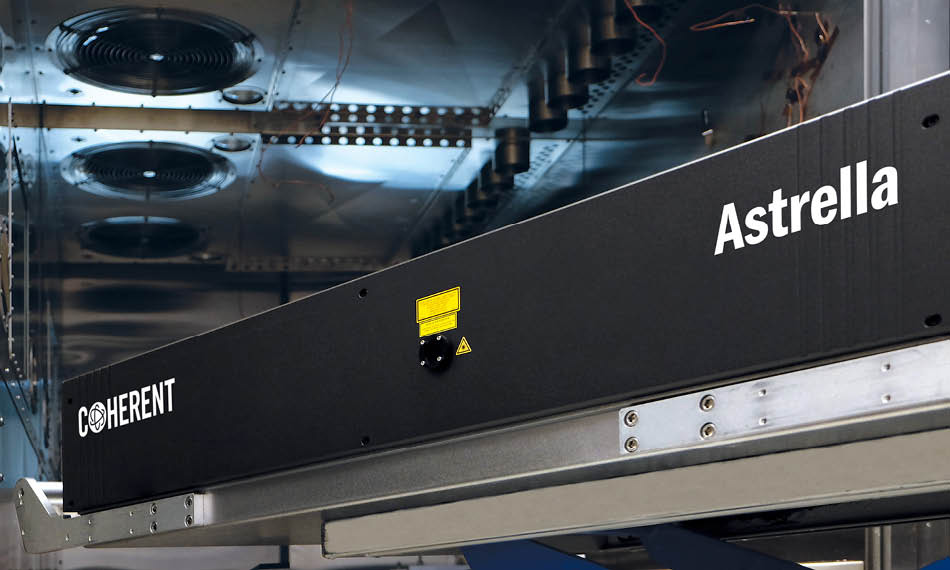
Figure 1: HALT/HASS testing and screening are key factors enabling industrial reliability in Astrella amplifiers
As a result, Astrella provides push-button performance with up to 7 mJ per pulse at 800 nm with < 35 fs pulse width at a repetition rate of 1 kHz. All the laser components are in the compact (26 cm x 79 cm x 125 cm) head. These amplifiers also deliver excellent long-term stability, which is essential in experiments like two-dimensional (2D) spectroscopy where data acquisition times may span tens of hours.
Several important emerging applications in physics, photochemistry, and materials science need even shorter pulse widths and/or very short wavelengths – for example, to generate extreme ultraviolet (EUV) pulses or pulse widths of a few femtoseconds. The transform-limited pulses from Astrella are characterized by low amplitude noise and high phase stability as well as high beam quality (M2 < 1.25). This means the pulses are also ideal for driving non-linear optical processes to reach these extreme operating domains.
Two-Dimensional Spectroscopy
Some of the most demanding applications for ultrafast amplifiers are the various embodiments of two-dimensional spectroscopy. In conventional spectroscopy, the light signal (IR absorption, Raman scattering, etc.) is recorded as a function of the excitation wavelength. In the last decade, many variations of two-dimensional spectroscopy techniques became increasing popular. Here laser pulses with as large a bandwidth as possible are used to determine how strongly different molecular vibration or electronic levels are coupled, as well as the dephasing time of these couplings. The data is usually graphed as two-dimensional contours as shown in figure 2. The shape of the vibration contours also provides information to enable the homogenous and heterogeneous components of the excited state lifetimes to be independently determined.
Although the 2D spectroscopy concept is easiest to understand when plotted in the frequency domain, in most experiments the data is acquired as Fourier transforms in the time domain. This is accomplished using broadband pulses from femtosecond sources to simultaneously span the frequency region of interest. Here a single broadband source and a pulse shaper generate a pulse sequence. Timing between two of the closely synchronized pulses is transformed into the frequency domain and scanning the timing between the two pairs enables the dephasing lifetime to be determined, which is sometimes called 3D data. Get a more detailed explanation in the Xiong whitepaper.
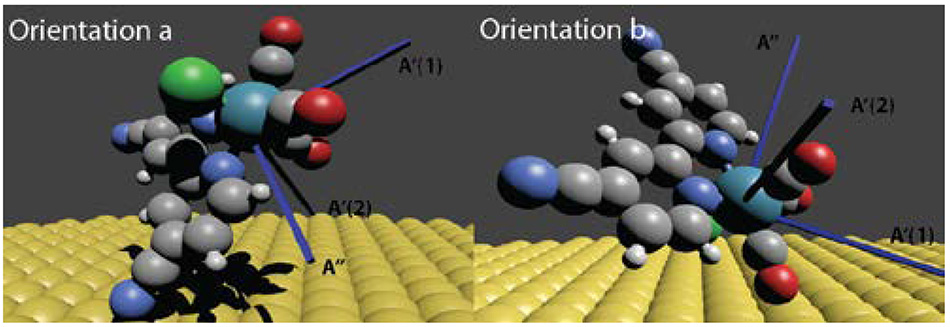
Figure 2. Orientations of the catalyst on gold surface determined from HD 2D SFG data and data from reflection mode IR spectroscopy, simulated using Density Functional Theory (DFT). Orientation ”a” is preferred. Blue sticks represent the vibrational modes direction. Inset shows 2D data plots from this study – 2D SFG data for the surface-bound catalyst and 2D IR data showing the same vibrational information for the catalyst in solution.
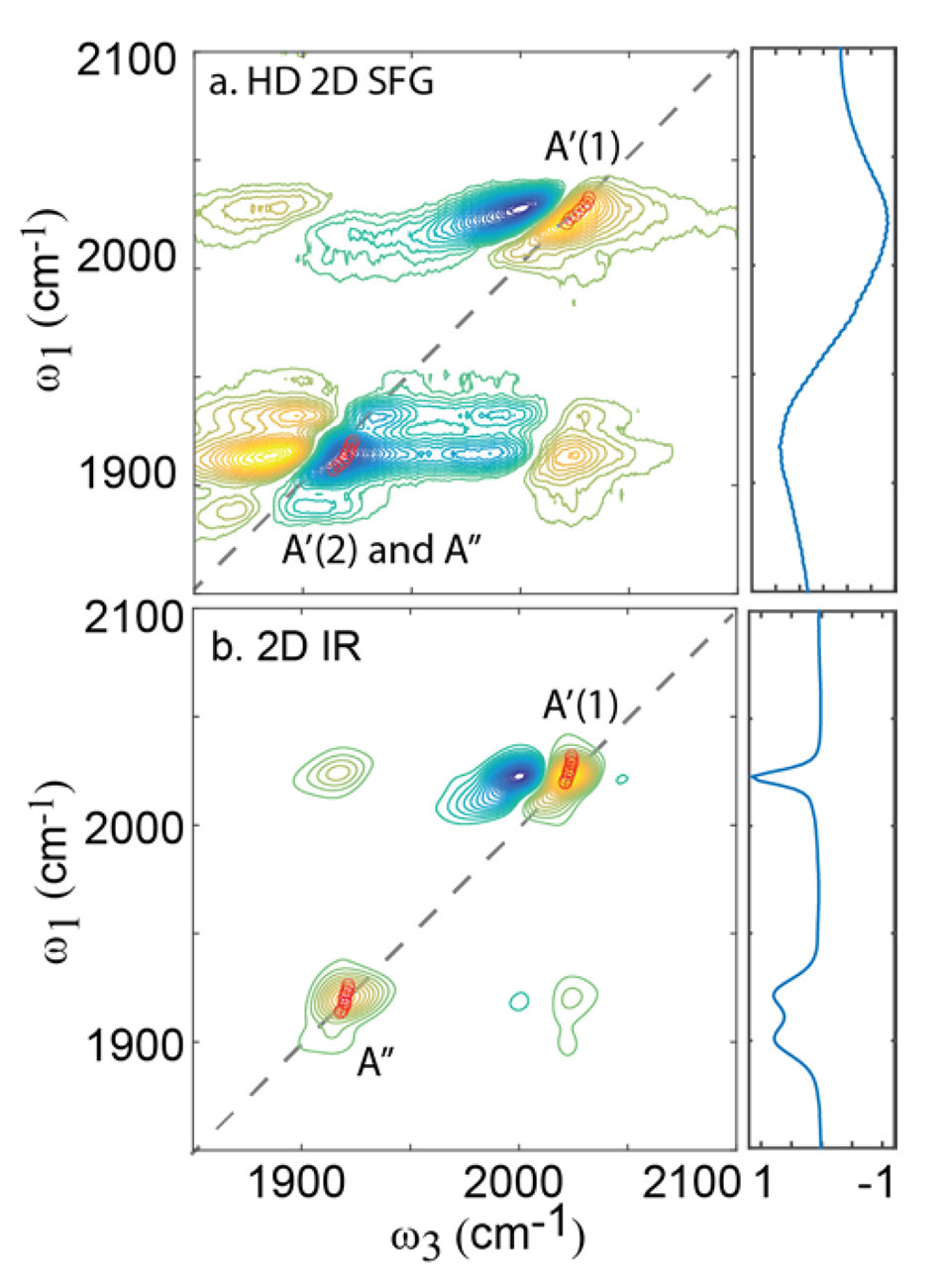
Professor Wei Xiong’s group at the University of California, San Diego, is using 2D spectroscopy to examine how a heterogenous catalyst - Re(diCN-bpy)(CO)3Cl - is bound to a gold surface and how this binding affects its dynamics (see figure 2). This chemical is a CO2 reduction catalyst, and is thus a candidate for use in sustainable energy schemes.
Xiong’s teams are performing experiments based on sum frequency generation (SFG), a technique originally developed by Xiong as a graduate student in the lab of Martin Zanni. 2D SFG is ideal for studying surface-bound catalysts because SFG vibrational signals are only generated at surfaces and phase interfaces. This largely eliminates potentially huge background noise due to unbound (in solution) catalyst molecules. However, because the catalyst is bound as a monolayer, the SFG signal itself is extremely weak. And since the signal has non-linear dependence on laser intensity, high pulse energies, and short pulse widths are absolutely essential; this is why Xiong selected Astrella for this work. The other reasons he cites for investing in Astrella as the lab’s main ultrafast source are its ease of use and long-term stability. “To obtain a full set of spectra at different delay times – 3D data – we sometimes have to average data for 48 hours, which puts extreme demands on laser stability. During this period it is critical that the amplifier output be stable and without drifts in beam pointing, beam quality, pulse energy, etc. The stability of Astrella means we can do these long data runs while remotely controlling the laser from an office near the laboratory.” Xiong’s group have used this setup to determine the specific orientation of the catalyst on the gold surface (see figure 2) and the effect of surface binding on the dynamic coupling between key vibrations.
Simple Access to High Energy sub-5-fs Pulses
Astrella provides turnkey access to pulse widths shorter than 35 fs with pulse energies in excess of 7 mJ. Yet, several important emerging applications in physics, photochemistry, and materials science need even shorter pulses and/or higher peak powers – for example, to generate attosecond X-ray pulses, or to create bursts of relativistic electrons. Recently Coherent collaborated with Professor John Tisch and Dr. Daniel Walke from Imperial College of London, and scientists from Sphere Ultrafast Photonics to exploit the turnkey simplicity and stable beam quality from an Astrella amplifier to reach 5 fs pulse widths with pulse energies as high as 2 mJ. As shown in figure 3, a key element of this setup was a differentially pumped hollow fiber compressor (HFC) developed by Tisch’s group that was used to generate the ultrashort pulses. The other important component was the d-scan pulse compression/measurement system pioneered by the Sphere team.
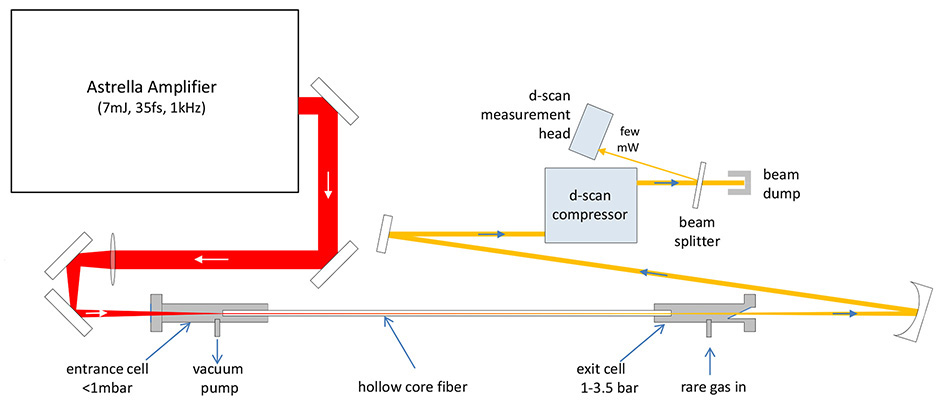
Figure 3: Experimental set up for 5 fs pulse generation and measurement. The output of a Coherent Astrella amplifier is focused by a lens (f=1 m) into a 250 μm inner-diameter, differentially-pumped hollow core fiber, pressurized with either neon or helium gas. The pulse energy from the Astrella is controlled over the range 0-7 mJ with a waveplatepolarizer combination (not shown). The spectrally broadened output from the hollow core fiber is re-collimated by a concave silver mirror (f=0.75 m) before it is both compressed and measured by the d-scan blue system. Only a few mW of average power is required for the d-scan measurement head, so beamsplitters are used to sample the watt level (~1 mJ @ 1 kHz) beam from the hollow fiber. The beam entering the beam dump would in general be available for experiments. (Inset shows typical d-scan output data in the time domain, both the Fourier transform limited pulse and actual retrieved pulse, revealing a duration of 5.1 fs FWHM in this case.
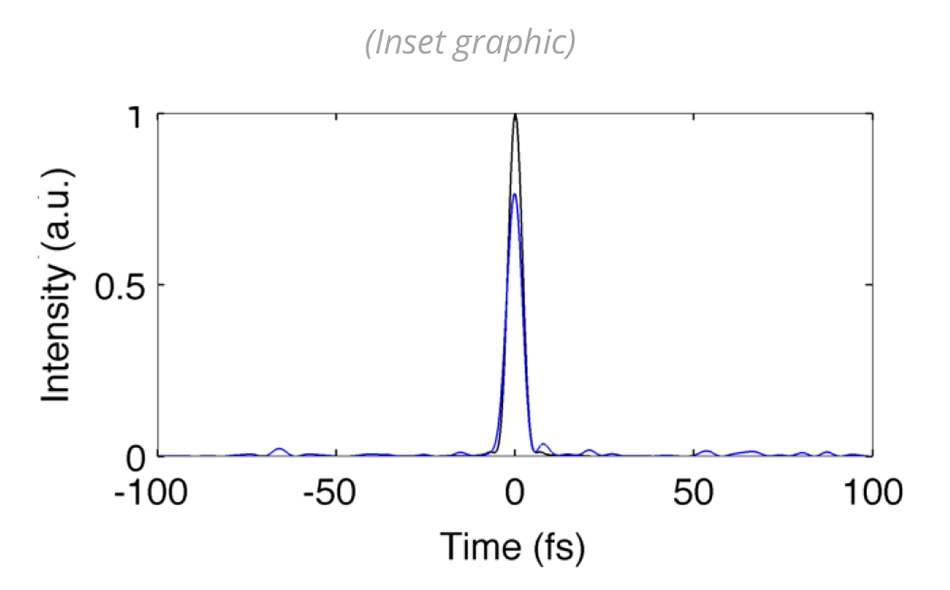
This approach takes advantage of the spectral broadening caused by self-phase modulation (SPM) in a hollow fiber containing a noble gas. The fiber acts as a dielectric waveguide, confining the beam and allowing for a long interaction length at a high intensity. This established approach is proven to allow the generation of high-power (up to 5 mJ), few-cycle laser pulses at kHz repetition rates.
A key innovation here is to differentially pump the HFC. As pioneered by Tisch and others, differential pumping reduces plasma formation at the fiber entrance where the laser intensity is highest. (In a statically gas-filled hollow fiber, plasma formation at the input side would otherwise cause a reduction in both coupling efficiency and shot-to-shot stability, by altering the size and position of the focus at the entrance from its optimum.) The Astrella pulses were focused by a 1-meter focal length lens to a beam waist of ~160 µm at the HFC input. The system ran repeatedly for many hours at a time, without any active feedback or re-alignment by the users, due to the high stability input beam from the Astrella amplifier.
There are several approaches that can characterize various aspects of femtosecond pulses but the d-scan unit used in this demonstration offers a number of advantages, including its ability to measure and compress pulses in the few-cycle regime with world-record durations (down to single-cycle pulses). The overall ease and speed of use makes d-scan the perfect tool for HCF measurement and optimization. First, it can perform both the compression/control and temporal measurement in a single unit. Second, it is a robust self-contained tool that is very tolerant of input beam misalignment (even ± a few degrees) and therefore quick to set up. Third, it is fast, providing a complete pulse characterization (phase and amplitude) in less than 1 minute for kilohertz pulse repetition rates.
As shown in the data plot in figure 3, this compact and relatively simple setup provides turnkey access to pulse widths of 5 fs with pulse energies at the millijoule level. Get a more detailed description of the demo.
A Convenient Source of Coherent Broadband EUV (12-50 nm) Pulses
When pumped by amplified femtosecond laser pulses, a waveguide filled with inert gas can instead be configured and optimized for high harmonic generation (HHG) in order to reach short wavelength regimes such as the extreme ultraviolet (EUV). Recent collaborative tests conducted by Coherent and K-M Labs have shown that the power, stability, and beam quality of Astrella make it ideal for driving a High Harmonic Generation (HHG) waveguide device such as the KMLabs XUUS4™ series. (As with the HFC pulse compressor, optimum performance is achieved by differential pumping to create a pressure gradient along the device.) Just as the invention of the laser has revolutionized science and technology in recent decades, the development of tabletopscale coherent laser sources at EUV and shorter wavelengths is likely to have a transformative impact on science and technology applications requiring laser-like performance at these short wavelengths.
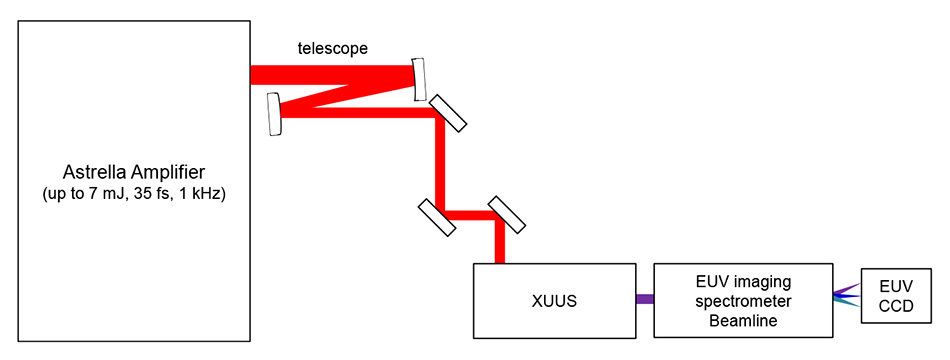
Figure 4: Schematic illustration of the setup used to generate EUV pulses. Inset shows the recorded spectrum of the EUV pulses when the HHG gas is helium with an optimized input pulse energy of 6m. The spectral bandwidth (FWHM) of the different harmonics is approx. 0.75 nm.
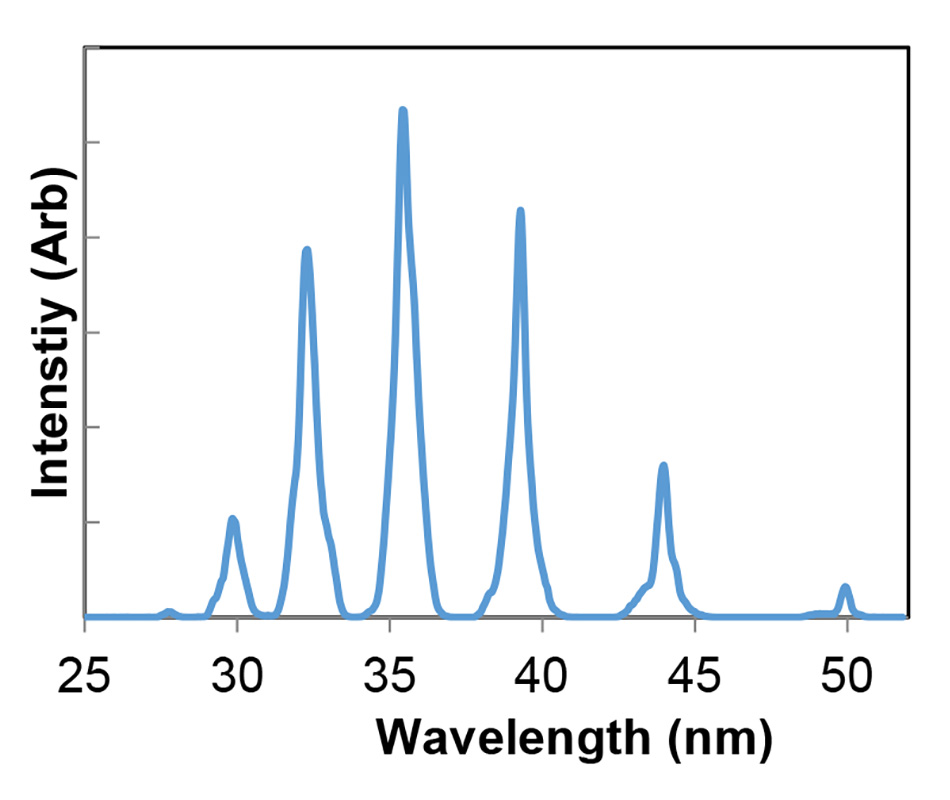
Figure 4 shows the main components used in this successful HHG demonstration. The HHG was analyzed using an EUV imaging spectrometer followed by a EUV CCD array detector. When argon is used as the fill gas, the output consists of several harmonics centered in the “near-EUV” at 35 nm. When helium is used, the output is centered at 13.5 nm in the deep UV. Alternatively, the waveguide can be filled with one of the heavier inert gases - xenon or krypton – to generate longer wavelength harmonics. In all cases, the optimum input pulse energy for HHG was found to be less than the output pulse energy of Astrella, leaving the option of using the extra pulse energy for combined experiments, e.g., for pump-probe type studies.
The shape of the EUV spectra (see figure 4) is the result of several factors, including the peak intensity of the laser at the time during the pulse when the emission is bright and phase-matched, the re-absorption of the longer wavelengths in the inert gas, and the transmission of the aluminum filters, which were used to reject the fundamental and lower-order harmonics. Get a more detailed description of the HHG tests.
Summary
Coherent pulses featuring broad bandwidth, EUV wavelengths, and/or ultrashort (5 fs) pulse widths, have been available for quite some time but the complexity of the sources previously required to obtain these pulse parameters confined their use to a handful of specialty labs, precluding widespread applications. Now the availability of turnkey amplifiers and reliable but sophisticated accessories provides simple access to extreme femtosecond performance, benefiting applications from attosecond physics to multidimensional spectroscopy.